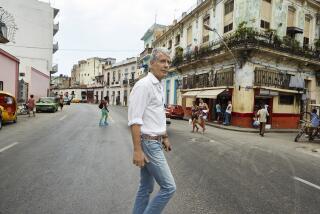William Murray, 78; Novelist Was an Expert on Horse Racing
William Murray, a writer best known for his popular series of mystery novels set in the world of horse racing and for his longtime “Letter From Italy” column for New Yorker magazine, has died. He was 78.
Murray, a resident of Del Mar Heights in San Diego County, died of a heart attack Wednesday in a hospital in New York City, where he had been meeting with one of his book publishers, said his agent, Frank R. Scatoni.
Murray was often described as America’s answer to Dick Francis, the Welsh-born jockey-turned-mystery writer.
“Between them, Dick Francis and William Murray have done more to popularize horse races than parimutuel betting,” Times critic Charles Champlin wrote in 1991.
Beginning with “Tip on a Dead Crab” in 1984, Murray chronicled horse racing’s “degenerate bettors and hard-knockers” in nine mystery novels whose protagonist was a close-up magician and inveterate horseplayer named “Shifty” Lou Anderson.
“Dead Heat,” Murray’s first racetrack-set mystery since 1996 and due out in September by Eclipse Press, will feature a new protagonist, Sal “Bones” Righetti, an ex-mob heavy turned good guy.
Jackie Duke, Murray’s editor, told The Times on Thursday that she was impressed with Murray’s “convincing characters and his description of life on the racetrack.”
“When he describes the running of a race, the reader feels as if he is right among the competing horses,” she said. “He’s obviously an expert as far as horse racing.”
Murray was a true aficionado of the sport, having gotten hooked as a prep-school student when he saw his first horse race at the old Aqueduct racetrack in New York.
As Champlin wrote in 1991: “As a devout student of the Racing Form, Murray gives us the sport seen from railside, and the hopes that spring eternal among railbirds, even within a blizzard of torn tote tickets.”
Murray, who had lived only a few miles from the Del Mar racetrack since 1986, was a fixture at the seaside oval, which he discovered in the mid-1960s after moving to Malibu.
“I love it from the first roar of the crowd at the first race of the day,” he is quoted as saying in an article on Southern California racetracks that ran in The Times’ Weekend Calendar on Thursday.
“No matter where you were, whenever you ran across him, he always had the Racing Form, a program, his glasses on the end of his nose, and he was handicapping,” Joe Harper, president of the Del Mar Thoroughbred Club, said Thursday.
“He became one of the characters in his books,” said Harper, who knew Murray for 20 years. “He was probably more Runyonesque than a lot of the characters he wrote about because of his passion and the love that he had for racing.”
Murray, who owned six thoroughbred racehorses in the 1980s, also wrote three nonfiction books about the sport, the most famous of which is “The Wrong Horse: An Odyssey Through the American Racing Scene” (1992).
As a writer, Murray often wrote about his passions, which included Italy (where he lived for many years and visited often) and opera (he was an aspiring opera singer in his youth and later sang with the San Diego Gilbert & Sullivan Company, among others).
He expressed his lifelong love affair with Italy in several books: “The Last Italian: Portrait of a People,” a 1991 collection of essays that was compared by the New York Times to the writings of famed travel essayist A.J. Liebling; “Italy: The Fatal Gift” (1982), another collection of essays; and “City of the Soul: A Walk in Rome” (2003).
He recently spent a year with the Lyric Opera of Chicago to write his forthcoming book “Fortissimo: Backstage at the Opera With Sacred Monsters and Young Singers,” which will be released by Crown Publishing in the fall.
Born in New York in 1926, Murray was the son of Natalia Danesi Murray, a journalist and radio reporter, and William Murray Sr., an agent and onetime head of the William Morris agency.
Murray, whose parents separated when he was 2, spent his first eight years living in his mother’s native Italy.
They returned to the United States in 1934, and he was educated at Phillips Exeter Academy in New Hampshire and, for a time, at Harvard.
In the early 1940s, his mother began a love affair with celebrated New Yorker writer Janet Flanner, which Murray chronicled in his 2000 memoir “Janet, My Mother, and Me.”
After serving in the Army Air Forces during World War II, Murray moved to Rome and studied voice for five years before abandoning his dream of becoming an opera singer and turning to writing fiction and journalism. While studying music, he worked part time for the Rome bureau of Time magazine.
He joined the New Yorker in 1956 as a reader of short story submissions and became a staff writer in 1961. A year later, he launched his column from Italy.
He would visit the country twice a year, his column taking its title from whatever city he was visiting, such as “Letter From Rome” or “Letter From Milan.” His last one ran in 1989.
Fluent in Italian, Murray was also known for translating into English the plays of Italian dramatist Luigi Pirandello.
His 1967 novel “The Sweet Ride” was turned into a feature film, and his 1980 novel “Malibu” was made into a television miniseries.
He is survived by his wife of 31 years, Alice; three children from his previous marriage to Doris Kuhns, William, Julia and Natalia; and two half-brothers, Richard and Michael Murray.
More to Read
Sign up for our Book Club newsletter
Get the latest news, events and more from the Los Angeles Times Book Club, and help us get L.A. reading and talking.
You may occasionally receive promotional content from the Los Angeles Times.






